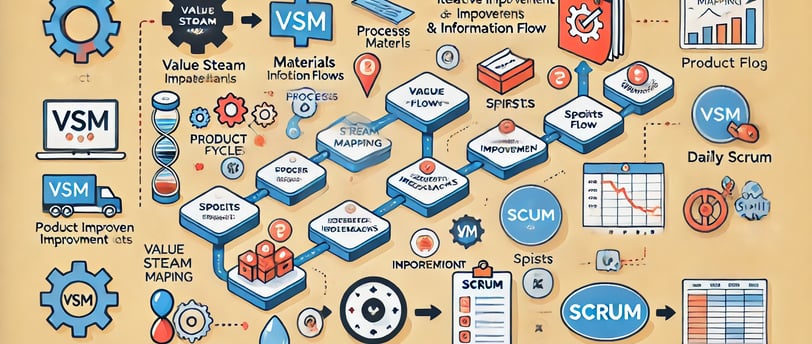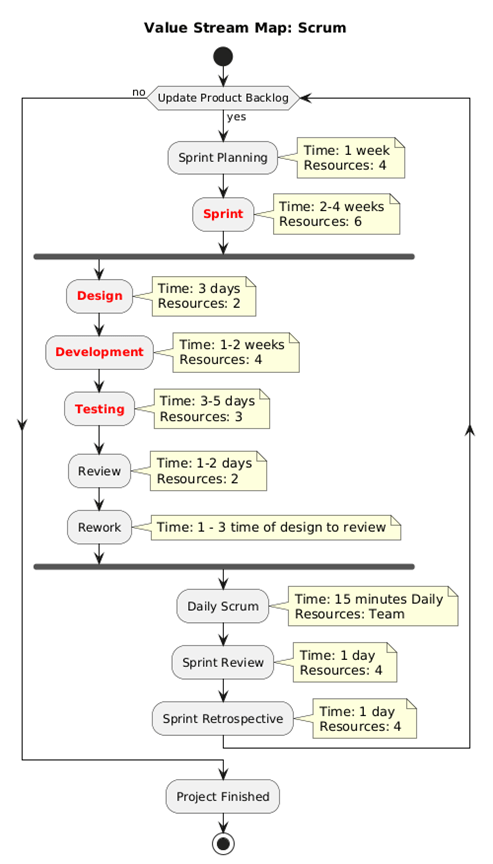Identifying Innovation Using Value Stream Mapping (VSM) and Scrum for Decreasing Time
Blog posts describe innovation and process optimization as essential in the ever-changing corporate world. This article discusses how integrating VSM with Scrum may save project management time and improve efficiency. A sophisticated lean-management technique, Value Stream Mapping (VSM), visualizes material and information flow to detect bottlenecks and waste. However, Scrum encourages iterative development, adaptability, and ongoing improvement. VSM and Scrum help teams visualize their processes, break work into sprints, and improve workflows. This article shows how to create a VSM for a software development project and use Scrum to organize work in iterative sprints. The article includes an actual case study that shows how to identify and eliminate bottlenecks, reduce lead and cycle times, and promote continuous improvement. A graphic picture of the process helps readers understand how these tools may be used. This thorough book is ideal for project managers, team leaders, and anybody wishing to innovate their company. It explains how to use VSM and Scrum to improve project management, efficiency, and time to market. on.
Roberto Vazquez
8/8/20243 min read


Innovation in project management is crucial for maintaining a competitive edge and improving efficiency. Combining methodologies like Value Stream Mapping (VSM) and Scrum can lead to significant time reductions and streamlined processes. This blog will explore how VSM and Scrum can be utilized to identify innovation and reduce time in project management.
Introduction to Value Stream Mapping (VSM)
Value Stream Mapping (VSM) is a lean-management method for analyzing the current state and designing a future state for the series of events that take a product or service from its beginning to the customer. VSM helps visualize the flow of materials and information, identifying bottlenecks and areas of waste that can be eliminated.
Critical Elements of VSM:
Processes: Steps involved in delivering the product or service.
Materials: Physical items used in the process.
Information Flow: Data required and generated during the process.
Lead Time: Total time taken from start to finish.
Cycle Time: Time taken to complete a single process.
Introduction to Scrum
Scrum is an agile framework for managing work with an emphasis on software development. It encourages teams to work in iterations, called sprints, to deliver incremental improvements to the product. Scrum focuses on flexibility, collaboration, and continuous improvement.
Critical Elements of Scrum:
Product Backlog: A prioritized list of features and requirements.
Sprint: A time-boxed iteration, typically lasting 2-4 weeks.
Daily Scrum: A daily stand-up meeting for team synchronization.
Sprint Review: A meeting to review the work completed during the sprint.
Sprint Retrospective: A meeting to reflect on the sprint and identify areas for improvement.
Combining VSM and Scrum
By combining VSM and Scrum, teams can create a powerful approach to identifying innovation and reducing time in their projects. Here's how:
1. Visualizing the Process with VSM
Begin by creating a VSM for the current process. This involves mapping each step, identifying the materials and information flow, and calculating lead and cycle times. This visual representation helps to pinpoint bottlenecks and areas of waste.
2. Integrating Scrum Framework
Once the VSM is created, integrate the Scrum framework into the process. This involves organizing the work into sprints, maintaining a product backlog, and holding regular Scrum ceremonies (daily scrums, sprint reviews, and retrospectives).
3. Identifying Bottlenecks and Waste
Use the VSM to identify bottlenecks and areas of waste within the process. These could be steps that take too long, require too many resources, or add little value to the final product.
4. Continuous Improvement
With each sprint, focus on addressing the bottlenecks and waste identified in the VSM. Use the sprint retrospective to reflect on the progress made and identify new areas for improvement.
5. Reducing Lead and Cycle Times
By continuously iterating and improving the process, teams can reduce lead and cycle times. This leads to faster delivery of products and services, allowing for more innovation and responsiveness to market changes.
Practical Implementation
Let's consider a software development project as an example to illustrate how VSM and Scrum can be combined.
Benefits of Combining VSM and Scrum
1. Improved Efficiency: By identifying and eliminating bottlenecks and waste, teams can improve efficiency and deliver products faster.
2. Increased Flexibility: Scrum's iterative approach allows teams to adapt and continuously improve the process.
3. Enhanced Collaboration: Regular Scrum ceremonies promote collaboration and communication among team members.
4. Better Quality: Continuous improvement leads to higher-quality products and services.
5. Faster Time-to-Market: Reduced lead and cycle times enable teams to deliver products faster, gaining a competitive edge.
Conclusion
Combining Value Stream Mapping (VSM) and Scrum provides a powerful approach to identifying innovation and reducing time in project management. By visualizing the process with VSM, integrating the Scrum framework, and focusing on continuous improvement, teams can eliminate bottlenecks and waste, improve efficiency, and deliver high-quality products faster. This approach fosters a culture of innovation, allowing organizations to stay competitive in a rapidly changing market.


